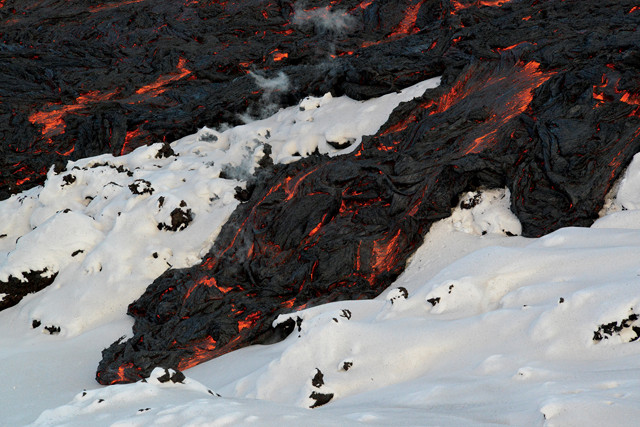
by Mary Caperton Morton Monday, March 9, 2015

A slow-moving eruption in Russia gave scientists a rare opportunity to safely study interactions between lava and snow in the field. Credit: Benjamin R. Edwards.
Many of the world’s volcanoes are high enough and cold enough to sport seasonal snow, and some even boast year-round glaciers. But what happens when those volcanoes erupt and molten lava hits snow and ice? Observing such extreme interactions of hot and cold is often dangerous in the field, but a slow-moving basaltic eruption in Russia in 2012 provided the right conditions to give scientists a close-up view on one fire-meets-ice display.
There are about 500 volcanoes on Earth where hazards related to snow and icepacks could occur during eruptions, says Ben Edwards, a volcanologist at Dickinson College in Carlisle, Pa., and lead author of a new study in Nature Communications describing the scene in Russia. These hazards include steam explosions and flooding.
When the Tolbachik volcano — located in the central part of Russia’s Kamchatka Peninsula — began erupting in 2012, Edwards seized the opportunity to study the slow-moving lava flow up close as it flowed on top of, beneath and through fractures in the meters-thick snowpack on the flanks of the mountain.
Edwards and his Russian colleagues dug 3-meter-deep observation pits into the snow ahead of the lava flow, allowing a cross-sectional view of the different interactions between the snow and two varieties of lava being extruded by the volcano. Blocky ‘a’a lava advanced on top of the snowpack, producing little steam, while the smooth-flowing pahoehoe lavas flowed under and inside the snowpack, melting the overlying snow and producing copious amounts of steam.
The flows were “pretty fascinating to observe, as nobody had ever seen this kind of behavior happening in real time before,” Edwards says. To the researchers’ surprise, there were no signs of the eruption causing flooding downslope. Flooding has occurred near some ice-clad volcanoes in South America and Iceland, where faster-flowing lava came in contact with glaciers, Edwards says. But as he and his colleagues observed at Tolbachik, “there were no big gushes of water preceding the lava” flows, likely because the snowpack holds less water than a glacier. To gain an understanding of the similarities and differences between lava-snow and lava-ice interactions will require further study in a variety of locations, Edwards says.
This study “presents a much more comprehensive look at these types of interactions than has been previously published,” says John Stevenson, a volcanologist at the University of Edinburgh who was not involved in the work. “Most of our understanding of lava and ice interactions comes from paleoeruptions, where ice that’s now long gone shaped lava flows in peculiar ways,” he says, “but this is the first time somebody has actually witnessed this happening and reported on it.”
Edwards says he would like to observe lava-ice interactions in Iceland and at Mount Etna in Sicily, but in the meantime he hopes the lava-snow findings from Tolbachik will be a useful guide for other studies investigating the link between volcanoes and climate. For instance, Edwards and his colleagues wrote, scientists can use volcanic deposits shaped by ice to help identify retreating snow-lines during past periods of climatic warming, or to investigate what time of year ancient eruptions occurred. The deposits may also hold clues about the duration of past eruptions if lava-flow fields contain textures indicative of both lava-snow interactions and snow-free conditions.
The findings may even have applications on other planets. “It may soon be possible to identify the characteristic deposits produced by lava-snow interactions on [Mars] and on other solar system bodies as well,” Edwards and colleagues wrote in their paper. “This may in turn lead to more accurate and detailed paleoclimate history reconstructions and a better understanding of planetary climate.”
© 2008-2021. All rights reserved. Any copying, redistribution or retransmission of any of the contents of this service without the expressed written permission of the American Geosciences Institute is expressly prohibited. Click here for all copyright requests.